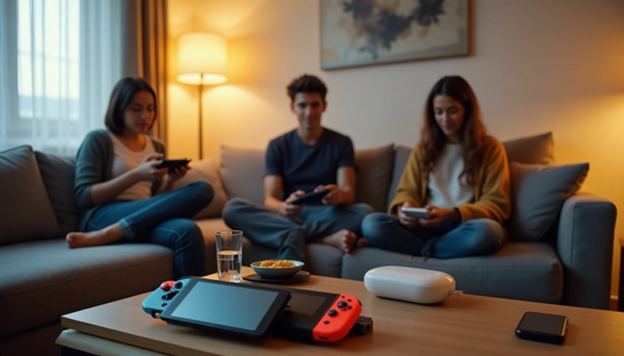Handheld gaming consoles show a remarkable comeback that will change the gaming world. This trend signals the start of portable gaming’s new golden age. Nostalgia plays a huge role. Players who grew up with Game Boy and PSP are happy to pick up handheld gaming consoles again to relive their favorite memories. This emotional bond has created a natural path for millions of players to accept new portable devices. These current trends in handheld gaming consoles mark the beginning of an exciting shift in portable gaming experiences.
Why Gamers Are Returning To Handheld Consoles
Handheld game consoles rule the market, and with good reason, too. They’ll capture 63.4% of the mobile and handheld gaming market share by 2034. Handheld gaming consoles give players something smartphones just can’t match. They are more powerful, allowing gamers to play more than just the best offshore online casinos without lag. They also use real buttons that give feedback and make gameplay more precise and fun. Players prefer these physical controls over touchscreens, especially when games need quick reactions.
Today’s portable devices have fixed the old technical issues. Modern handhelds now come with powerful hardware that runs AAA titles smoothly. Battery life has also improved, even with crystal-clear displays that require more power than screens with low resolution. Moreover, unlike regular consoles that need TV setups and extra gear, portable systems are ready to go right away. So, players can enjoy their games anywhere.
Money savings make these devices even more attractive. Handheld gaming consoles are affordable compared to traditional gaming setups. They’re easier to maintain than gaming PCs and don’t need constant upgrades. This approach brings gaming to new players who might not have the room or cannot afford traditional PC setups.
What Makes Today’s Handhelds Different
The latest handheld gaming PC devices pack desktop-level components into compact sizes. They are powerful computers that fit in your hands. Games that once needed a full desktop setup now run smoothly on these portable powerhouses. The new OLED and mini-LED displays show rich colors and deep blacks at 120Hz or higher refresh rates. Players can enjoy longer gaming sessions without the eye strain that older portable screens caused.
Furthermore, new efficient processors and bigger batteries have changed all that. Most current handheld gaming systems last 6-8 hours of heavy gaming, making them perfect for long trips. These devices also connect to Wi-Fi 6E and Bluetooth 5.2+ for smooth online gaming. You can connect them to displays and other accessories and devices.
The controls also feel completely different, using adaptive triggers and precise analog sticks that work better than traditional controllers. The comfortable design prevents your hands from getting tired during long gaming sessions.
Even better, players can access hundreds of games through subscription services, play titles across different platforms, and enjoy their classic favorites. This creates amazing value for gamers.
How Companies Are Shaping The Handheld Market
Major players are now fiercely competing to win their market share. Nintendo, Sony, Valve, Microsoft, ASUSTeK, Lenovo, and Qualcomm lead the global handheld gaming console market. These tech giants use unique strategies to stand out in this profitable space.
Additionally, big names like Samsung revealed their creative Flex Gaming concept with a 7.2-inch foldable OLED display. Acer brought its Nitro Blaze series to market with AMD Ryzen processors, 16GB memory, and up to 2TB storage. Nevertheless, Nintendo’s Switch 2 announcement created the most buzz by supporting both new exclusive games and existing Nintendo Switch titles.
To stay competitive, companies target different market segments through three main approaches: high-end gaming, casual/retro gaming, and mobile-focused gaming. More than 60% of game development studios also partner with hardware brands to create exclusive content bundles. These partnerships spark breakthroughs across the ecosystem.
Success depends on integration with large software ecosystems and unique features that separate companies from their rivals. This reality pushes companies to invest heavily in research and development.

What To Expect From The Handheld Gaming Boom
The mobile and handheld gaming market grows by about 6% yearly. Dedicated handheld gaming consoles should capture 63.4% of the market share by 2034. Sales of dedicated handheld gaming hardware will hit 29.3 million units worldwide by 2028. However, it’s new technologies that are changing the handheld gaming console experience:
- AI and Machine Learning create more tailored gaming experiences that could add billions in revenue by 2025
- 5G networks enable smooth cloud gaming with minimal delay
- AR and VR features are now available through lighter devices
Battery life stands out as the main goal for the next wave of handheld gaming PC devices. New models from major manufacturers will pack laptop-grade processors into small, portable devices. These hybrid gaming machines can stream games while moving and connect to TVs for 4K gaming at home.
Exciting new future handheld gaming devices are now also on the market. The latest Legion Go S runs SteamOS, making it the first non-Valve device with their operating system. MSI’s Claw 8 AI+ features an Intel Core Ultra 7 Series 2 CPU, and Acer just released its big 11-inch Nitro Blaze.
These new upgraded devices show what a world of handheld gaming trends might look like, changing how we play games and where we enjoy them.


